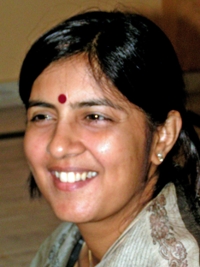The majority of monks and nuns I interviewed emphasized the slogan: Self-restraint is life. Interestingly, one female ascetic in her interview quoted Mahapragya[29] and said: "Self-restraint is life and an unrestrained life is death. Vows develop self-control and modern-day's diseases are caused due to an unrestrained life style."[30]
Her response entails that the movement professed a way to respond to modernization through self-restraint. In the course of my previous interviews, I had heard multiple versions of the already stated above theory. Thus, my next question was more direct: What is the difference between the traditional vows and the modernized vows for the contemporary Indians? A senior monk's response was intellectual but complicated. He stated: "One who has Samyag Drishti[31] can accept the traditional 12 anuvrat vows. However, the Tulsian version is the 11 vows, which anyone following any religion giving due importance to benevolent character can adopt."[32] An alternative response made by Professor Bhargava, was simple and potent. According to him, "there is a metaphysical difference between the two sets of vows. The prime objective of the anuvrat vows as elucidated in Sravakachara[33] is liberation of soul (moksha), whereas the objective of the Anuvrat Movement is purification of soul."[34] On further inquiry, he explained that the traditional vows are tied to a belief system and require a higher degree of self-restraint as compared to the Tulsian version of anuvrat vows. These views convey that the Anuvrat Movement has deviated from the traditional understanding of the Jain path and its goals for the laity. Thus, the Tulsian vows were a new approach to generate the spirit of self- restrain among the masses.
From various conversations and discussions on vows, I found that initially when Acharya Tulsi launched the movement there were 84 vows. Subsequently, there were vigorous analyses of the vows formed on the basis of feedback drawn from the early Anuvratis. As a result, the vows were reduced to 45. They were further consolidated to the present form, which is a code of conduct comprising of 11 vows. The reason given by a senior nun regarding the descending figure of the vows was:
Earlier Anuvrat was targeted towards big social problems like dowry, purdah etc. The quantity of vows reduced in the light of changing socio-cultural circumstances in India. Secondly, people feared keeping such a long list of rules in their already busy lives. To be an Anuvrati, one has to possess a strong will power and hold on to their vows. Generally, an Indian mind is dedicated to the sacredness of a vow. He/she is reluctant to violate the accepted vows for fear of the consequences, but do not hesitate breaking a civil law.[35]
The above reasons asserted by the nun indicate that the original 84 vows were presently less effective because of changes in social life. However, my inferences from her view are that while the problems of dowry and purdah might have been reduced, they have not disappeared from Indian society. The dowry amounts have increased from the past and purdah is still normative in some parts of India. The second point as understood by me is that people do not want a long list, only a simplification of vows in view of the increasing complexities of life. On the other hand, according to many respondents, the present generation is more educated and spiritually aware; and future generations may be even more cognizant of their spirituality. So far, the vows have demonstrated great flexibility and have been open to modification depending upon the circumstances.
Regarding the accepting of vows, it would be instructive to bring in an example of the Quaker Movement from the Christian tradition, to provide contrast and similarity between different cultures. Self-improvement forms one of the core values for the Quakers too. However, unlike the Anuvrat Movement, the Quakers will not take formal oaths, or engage in "promises" since they say: if you say you will do something, you should do it (let your yea be yea and your nay be nay).[36]
 Shivani Bothra
Shivani Bothra
